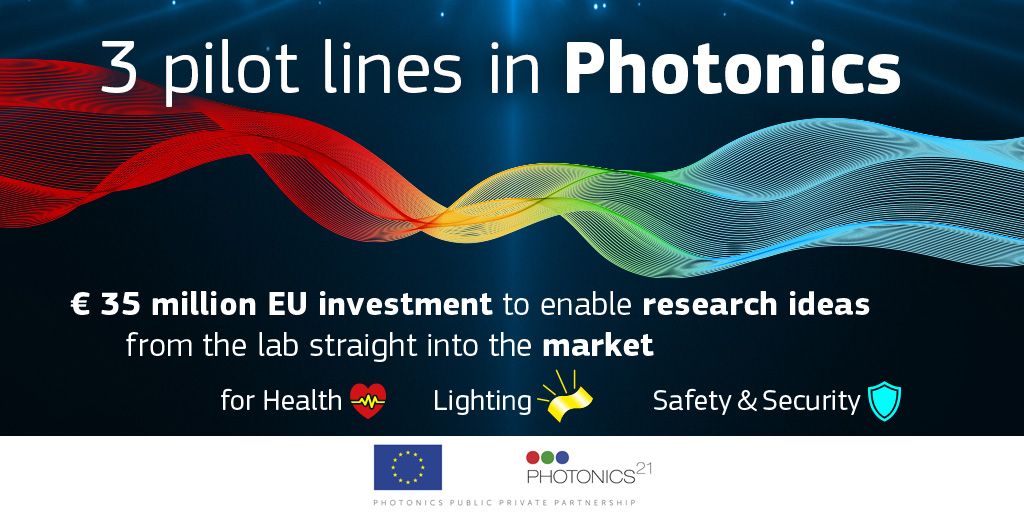Three major Pilot Lines, which help SMEs take photonics technologies from lab into market, have been launched today by the Photonics Public Private Partnership (PPP). The Pilot Lines mean that thousands of high tech SMEs in Europe - who often lack access to advanced, cost-intensive infrastructures and expertise needed to manufacture new and innovative products – will be able to take their good ideas, scale-them up and validate them with the first customers for commercial production. The Pilot Lines will focus on health applications, flexible organic light-emitting diodes and sensors for the detection of chemicals in gas and liquids. The European Commission has invested EUR 35 million (US $38.66 million) in these projects to boost Europe's industrial competitiveness. This is part of the Commission's EUR 700 million investment in the Photonics Public Private Partnership over the seven years of HORIZON 2020, the Framework Programme for Research and Innovation.
“With these Pilot Lines Europe will position itself at the forefront of innovation in photonics. Our companies, and in particular the manufacturing sector, will have access to support for innovation and the facilities needed to get ahead in global markets. Photonics is a crucial component for the successful digitalisation of European industry and the economy” said European Commissioner for Digital Economy and Society Günther H. Oettinger.
 |
|
(Photo courtesy of Photonics21) |
The Photonics PPP was LAUNCHED IN DECEMBER 2013 by the European Commission in order to reinforce European leadership in PHOTONICS, one of the key enabling technologies (KETs). Photonics are driving innovation in many areas, from communications to advanced energy efficient lighting, and from early detection of diseases to safety and security.
The Photonics PPP links up the European industry (large players and SMEs), researchers, academia and the European Commission to cooperate in research and innovation in the Photonics domain and define strategic roadmaps in sectors which can shape the future digital economy of the EU and revolutionise the industrial landscape. The Photonics PPP is characterised by having a strong impact in cross-cutting areas: that is why Photonics can drive the transformation of EU into a digital society and strengthen Europe's Digital Single Market.
The three manufacturing Pilot Lines are PIX4LIFE, MIRPHAB and PI-SCALE.
PIX4Life (HTTP:http://PIX4LIFE.EU) is a pilot for a state-of-the-art photonics platform for health applications. Recently, a promising Silicon Nitride Photonic Integrated Circuit technology was researched to make compact, low cost detection and imaging systems in the visible range and the TriPleXTM and BioPIX platforms were developed. PIX4Life will scale up these platforms in order to bring Silicon Nitride based systems towards commercial production and industrial take up. This will open a multibillion market of products including biosensors, cytometers, DNA sequencers, gas sensors, microscopes, medical imagers and more. The PIX4Life pilot line will drive European leadership inhealth applications by making this technology accessible to industrial and academic customers together with the necessary design, packaging and test services. The project brings together 15 leading organisations from 7 European countries and is coordinated by IMEC, Belgium.
PI-SCALE (WWW.PI-SCALE.EU) is a pilot line providing open access services to a wide range of external users in order to accelerate the commercial adoption of flexible Organic Light-Emitting Diodes (OLEDs). These large area, energy efficient light sources are ultra-thin, flexible, lightweight films which can be made or cut to any shape or size allowing new opportunities to create high value-added products in many different application areas, such as architectural lighting, automotive, aerospace, consumer electronics and the built environment. PI-SCALE will offer world class capability in pilot production services for customised flexible OLEDs. It will enable companies to quickly and cost effectively test and scale up their flexible OLED lighting concepts and turn them into market ready products. PI-SCALE brings together 14 expert partners, from 5 European countries and is coordinated by Holst Centre, the Netherlands.
MIRPHAB (HTTP:http://WWW.MIRPHAB.EU/) is a pilot line for prototyping and production of innovative sources and sensors in the Mid-IR range, for the detection of chemicals in gas and liquids. MIRPHAB platform is based on miniaturized laser systems and will allow the manufacturing of compact, low cost and low power consumption sensing devices which can be used for safety, security and environmental applications. The industry partners involved in MIRPHAB are committed to deploy new products swiftly in the market and achieve prompt take up in the environmental and chemical sensing areas. The project brings together 18 leading organisations from 9 European countries and is coordinated by CEA-Leti, France.












